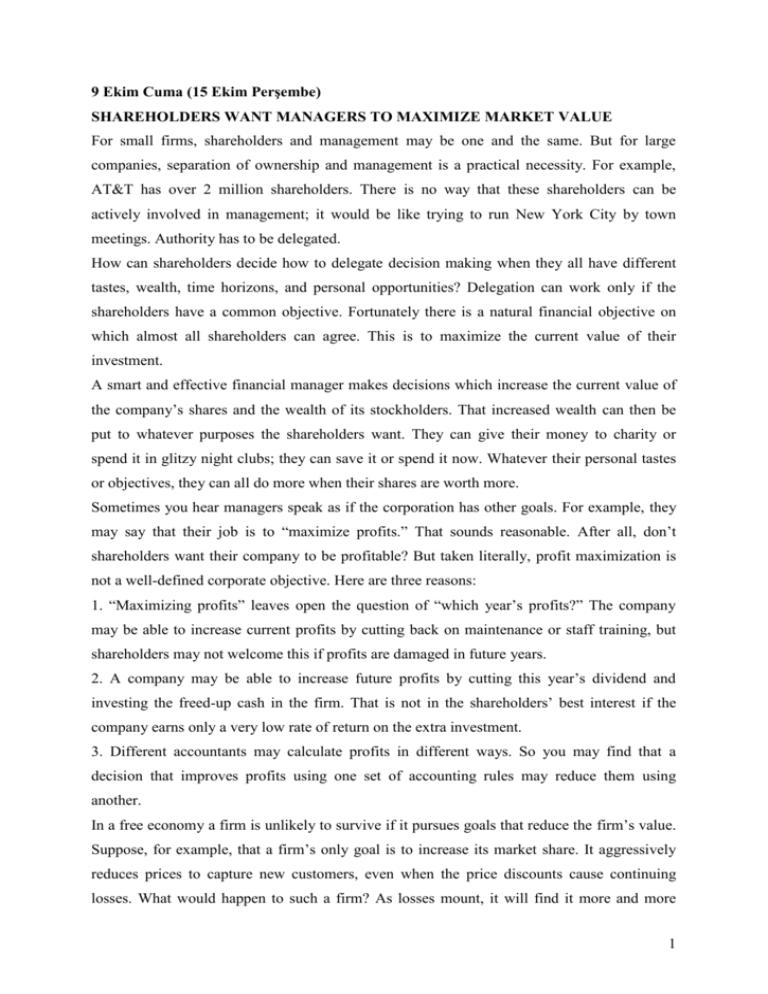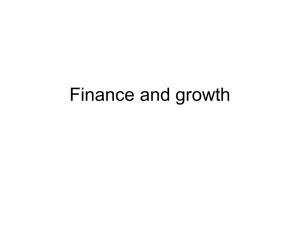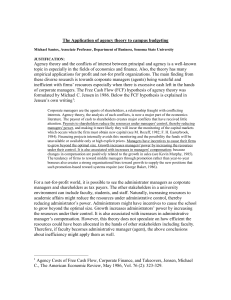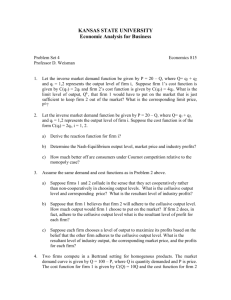6 kasim 2009 cuma
advertisement

9 Ekim Cuma (15 Ekim Perşembe) SHAREHOLDERS WANT MANAGERS TO MAXIMIZE MARKET VALUE For small firms, shareholders and management may be one and the same. But for large companies, separation of ownership and management is a practical necessity. For example, AT&T has over 2 million shareholders. There is no way that these shareholders can be actively involved in management; it would be like trying to run New York City by town meetings. Authority has to be delegated. How can shareholders decide how to delegate decision making when they all have different tastes, wealth, time horizons, and personal opportunities? Delegation can work only if the shareholders have a common objective. Fortunately there is a natural financial objective on which almost all shareholders can agree. This is to maximize the current value of their investment. A smart and effective financial manager makes decisions which increase the current value of the company’s shares and the wealth of its stockholders. That increased wealth can then be put to whatever purposes the shareholders want. They can give their money to charity or spend it in glitzy night clubs; they can save it or spend it now. Whatever their personal tastes or objectives, they can all do more when their shares are worth more. Sometimes you hear managers speak as if the corporation has other goals. For example, they may say that their job is to “maximize profits.” That sounds reasonable. After all, don’t shareholders want their company to be profitable? But taken literally, profit maximization is not a well-defined corporate objective. Here are three reasons: 1. “Maximizing profits” leaves open the question of “which year’s profits?” The company may be able to increase current profits by cutting back on maintenance or staff training, but shareholders may not welcome this if profits are damaged in future years. 2. A company may be able to increase future profits by cutting this year’s dividend and investing the freed-up cash in the firm. That is not in the shareholders’ best interest if the company earns only a very low rate of return on the extra investment. 3. Different accountants may calculate profits in different ways. So you may find that a decision that improves profits using one set of accounting rules may reduce them using another. In a free economy a firm is unlikely to survive if it pursues goals that reduce the firm’s value. Suppose, for example, that a firm’s only goal is to increase its market share. It aggressively reduces prices to capture new customers, even when the price discounts cause continuing losses. What would happen to such a firm? As losses mount, it will find it more and more 1 difficult to borrow money, and it may not even have sufficient profits to repay existing debts. Sooner or later, however, outside investors would see an opportunity for easy money. They could offer to buy the firm from its current shareholders and, once they have tossed out existing management, could increase the firm’s value by changing its policies. They would profit by the difference between the price paid for the firm and the higher value it would have under new management. Managers who pursue goals that destroy value often land in early retirement. 16 Ekim Cuma CAREERS IN FINANCE In the United States well over 1 million people work in financial services, and many others work in the finance departments of corporations. We can’t tell you what each person does all day, but we can give you some idea of the variety of careers in finance. We explained earlier that corporations face two principal financial decisions: the investment decision and the financing decision. Therefore, as a newly recruited financial analyst, you may help to analyze a major new investment project. Or you may instead help to raise the money to pay for it, perhaps by a new issue of debt or by arranging to lease the plant and equipment. Other financial analysts work on short-term financial issues, such as collecting and investing the company’s cash or checking whether customers are likely to pay their bills. Financial analysts are also involved in monitoring and controlling risk. For example, they may help to arrange insurance for the firm’s plant and equipment, or they may assist with the purchase and sale of options, futures, and other exotic tools for managing risk. Instead of working in the finance department of a corporation, you may join a financial institution. The largest employers are the commercial banks. We noted earlier that banks collect deposits and relend the cash to corporations and individuals. If you join a bank, at some point you may well work in a branch, where individuals and small businesses come to deposit cash or to seek a loan. Alternatively, you may be employed in the head office, helping to analyze a $100 million loan to a large corporation. Banks do many things in addition to lending money, and they probably provide a greater variety of jobs than other financial institutions. For example, individuals and businesses use banks to make payments to each other. So if you work in the cash management department of a large bank, you may help companies electronically transfer huge sums of money as wages, taxes, and payments to suppliers. Banks also buy and sell foreign exchange, so you could find yourself working in front of one of those computer screens in a foreign exchange dealing 2 room. Another glamorous bank job is in the derivatives group, which helps companies to manage their risk by buying and selling options, futures, and so on. This is where the mathematicians and the computer buffs thrive. Investment banks, such as Merrill Lynch or Goldman Sachs, help companies sell their securities to investors. They also have large corporate finance departments which assist firms in major reorganizations such as takeovers. When firms issue securities or try to take over another firm, frequently a lot of money is at stake and the firms may need to move fast. Thus, working for an investment bank can be a high-pressure activity with long hours. It can also be very well paid. The distinction between commercial banks and investment banks is narrowing. For example, commercial banks may also be involved in new issues of securities, while investment banks are major traders in options and futures. Investment banks and commercial banks may even be owned by the same company; for example, Salomon Smith Barney (an investment bank) and Citibank (a commercial bank) are both owned by Citigroup. The insurance industry is another large employer. Much of the insurance industry is involved in designing and selling insurance policies on people’s lives and property, but businesses are also major customers. So if you work for an insurance company or a large insurance broker, you could find yourself arranging insurance on a Boeing 767 in the United States or an oil rig in Kazakhstan. A mutual fund collects money from individuals and invests in a portfolio of stocks or bonds. A financial analyst in a mutual fund analyzes the prospects for the securities and works with the investment manager to decide which should be bought and sold. Many other financial institutions also contain investment management departments. For example, you might work as a financial analyst in the investment department of an insurance company and help to invest the premiums. Or you could be a financial analyst in the trust department of a bank which manages money for retirement funds, universities, and charitable bodies. Stockbroking firms and bond dealers help investment management companies and private individuals to invest in securities. They employ sales staff and dealers who make the trades. They also employ financial analysts to analyze the securities and help customers to decide which to buy or sell. Many stockbroking firms are owned by investment banks, such as Merrill Lynch. Investment banks and stockbroking firms are largely headquartered in New York, as are many of the large commercial banks. Insurance companies and investment management companies tend to be more scattered. For example, some of the largest insurance companies are 3 headquartered in Hartford, Connecticut, and many investment management companies are located in Boston. Of course, many financial institutions have large businesses outside the United States. Finance is a global business. So you may spend some time working in a branch overseas or making the occasional trip to one of the other major financial centers, such as London, Tokyo, Hong Kong, or Singapore. Finance professionals tend to be well paid. Starting salaries for new graduates are in the region of $30,000, rather more in a major New York investment bank and somewhat less in a small regional bank. But let us look ahead a little: Table 1.2 gives you an idea of the compensation that you can look forward to when you become a senior financial manager. Table 1.3 directs you to some Internet sites that provide useful information about careers in finance. 30 EKİM 2009 CUMA THE CAPITAL BUDGETING DECISION Capital budgeting decisions are central to the company’s success or failure. For example, in the late 1980s, the Walt Disney Company committed to construction of a Disneyland Paris theme park at a total cost of well over $2 billion. The park, which opened in 1992, turned out to be a financial bust, and Euro Disney had to reorganize in May 1994. Instead of providing profits on the investment, accumulated losses on the park by that date were more than $200 million. Contrast that with Boeing’s decision to “bet the company” by developing the 757 and 767 jets. Boeing’s investment in these planes was $3 billion, more than double the total value of stockholders’ investment as shown in the company’s accounts at the time. By 1997, estimated cumulative profits from this investment were approaching $8 billion, and the planes were still selling well. Disney’s decision to invest in Euro Disney and Boeing’s decision to invest in a new generation of airliners are both examples of capital budgeting decisions. The success of such decisions is usually judged in terms of value. Good investment projects are worth more than they cost. Adopting such projects increases the value of the firm and therefore the wealth of its shareholders. For example, Boeing’s investment produced a stream of cash flows that were worth much more than its $3 billion outlay. Not all investments are in physical plant and equipment. For example, Gillette spent around $300 million to market its new Mach3 razor. This represents an investment in a nontangible asset—brand recognition and acceptance. Moreover, traditional manufacturing firms are not the only ones that make important capital budgeting decisions. For example, Intel’s research 4 and development expenditures in 1998 were more than $2.5 billion.4 This investment in future products and product improvement will be crucial to the company’s ability to retain its existing customers and attract new ones. Today’s investments provide benefits in the future. Thus the financial manager is concerned not solely with the size of the benefits but also with how long the firm must wait for them. The sooner the profits come in, the better. In addition, these benefits are rarely certain; a new project may be a great success—but then again it could be a dismal failure. The financial manager needs a way to place a value on these uncertain future benefits. THE RELATIONSHIP BETWEEN STOCK PRICES AND EXCHANGE RATES EVIDENCE FROM TURKEY Abstract Over the past few decades, determining the effects of macroeconomic variables on stock prices and investment decisions has preoccupied the minds of economists. In the literature, there are many empirical studies to disclose the relationship between macroeconomic variables such as interest rate, inflation, exchange rates, money supply etc. and stock prices. However, the direction of causality still remains unresolved in both theory and empirics. In this paper we investigate the causal relationship between stock prices and exchange rates, using data from 23 February 2001 to 11 January 2008 about Turkey. The reason of selecting this period is that exchange rate regime is determined as floating in this period. In this study, national 100, services, financials, industrials, and technology indices are taken as stock price indices. The results of empirical study indicate that there is bi-directional causal relationship between exchange rate and all stock market indices. While the negative causality exists from national 100, services, financials and industrials indices to exchange rate, there is a positive causal relationship from technology indices to exchange rate. On the other hand, negative causal relationship from exchange rate to all stock market indices is determined. 6 KASIM 2009 CUMA Introduction Many factors, such as enterprise performance, dividends, stock prices of other countries, gross domestic product, exchange rates, interest rates, current account, money supply, employment, their information etc. have an impact on daily stock prices (Kurihara, 2006: p.376). Especially, the continuing increases in the world trade and capital movements have made the 5 exchange rates as one of the main determinants of business profitability and equity prices (Kim, 2003). The relationship between stock prices and exchange rates has preoccupied the minds of economists since they both play important roles in influencing the development of a country’s economy. In the recent years, because of increasing international diversification, cross-market return correlations, gradual abolishment of capital inflow barriers and foreign exchange restrictions or the adoption of more flexible exchange rate arrangements in emerging and transition countries, these two markets have become interdependent. These changes have increased the variety of investment opportunities as well as the volatility of exchange rates and risk of investment decisions and portfolio diversification process. Thus, understanding this relationship will help domestic as well as international investors for hedging and diversifying their portfolio. Also, fundamentalist investors have taken into account these relationships to predict the future trends for each other (Phylaktis and Ravazzolo, 2005; Mishra et al., 2007; Nieh and Lee, 2001; Stavárek, 2005). Although, economic theory suggests that foreign exchange changes can have an important impact on the stock price by affecting cash flow, investment and profitability of firms, there is no consensus about these relationship and the empirical studies of the relationship are inconclusive (Joseph, 2002; Vygodina, 2006). However, the linkage between these financial variables can be established through the instruments of wealth, demand for money, interest rates etc. (Mishra, 2004). Most of countries adopted a floating exchange rate system with the Bretton Woods Agreement in 1973. Remarkable changes in exchange rates may occur every day. These changes require adjustments in costs or gains of multinational companies and increase exchange exposure to enterprises and financial institutions (Nieh and Wang, 2005). According to traditional approach, exchange rates lead stock prices. On the other hand, portfolio balance approach states that exchange rates are determined by market mechanism. In other words, changes in stock prices might have impact on exchange rate movements. This approach states that stock price is expected to lead exchange rate with a negative correlation since a decrease in stock prices reduces domestic wealth, which leads to lower domestic money demand and interest rates. Also, the decrease in domestic stock prices leads foreign investors to lower demand for domestic assets and domestic currency. These shifts in demand and supply of currencies cause capital outflows and the depreciation of domestic currency. On the other hand, when stock prices rise, foreign investors become willing to invest in a country’s equity securities. Thus, they will get benefit from international diversification. This 6 situation will lead to capital inflows and a currency appreciation. (Granger et al., 2000: p.338; Caporale et al., 2002; Stavárek, 2005; Pan et al, 2007). Exchange rate changes affect the competitiveness of firms through their impact on input and output price (Joseph, 2002). When the Exchange rate appreciates, since exporters will lose their competitiveness in international market, the sales and profits of exporters will shrink and the stock prices will decline. On the other hand, importers will increase their competitiveness in domestic markets. Therefore, their profit and stock prices will increase. The depreciation of exchange rate will make adverse effects on exporters and importers. Exporters will have advantage against other countries’ exporters and increase their sales and their stock prices will be higher (Yau and Nieh, 2006). That is, currency appreciation has both a negative and a positive effect on the domestic stock market for an export-dominant and an import-dominated country, respectively (Ma and Kao, 1990). Exchange rates can affect stock prices not only for multinational and export oriented firms but also for domestic firms. For a multinational company, changes in exchange rates will result in both an immediate change in value of its foreign operations and a continuing change in the profitability of its foreign operations reflected in successive income statements. Therefore, the changes in economic value of firm’s foreign operations may influence stock prices. Domestic firms can also be influenced by changes in exchange rates since they may import a part of their inputs and export their outputs. For example, a devaluation of its currency makes imported inputs more expensive and exported outputs cheaper for a firm. Thus, devaluation will make positive effect for export firms (Aggarwal, 1981) and increase the income of these firms, consequently, boosting the average level of stock prices (Wu, 2000). Nieh and Lee (2001) state that in an open economy, since the expectations of relative currency values affect the domestic and foreign interest rate and these changes affect the present value of a firm’s assets, exchange rates play a crucial role on stock prices, especially for internationally held financial assets. Wu (2000) explains the positive and negative relationship between exchange rate and stock prices by a real interest rate and an inflationary disturbance. According to real interest rate disturbance, when the real interest rate rises, capital inflow increases and the exchange rate falls. However, since higher real interest rate reduces the present value of future cash flows, stock prices will decline. An inflationary disturbance may explain negative relationship between exchange rate and stock price. That is, when inflation increases, the exchange rate rises and because of high inflation expectations, investors will demand a higher risk premium and high rate of return. As a result, stock prices will decrease (Wu, 2000: p. 261). 7 On the other hand, the asset market approach to exchange rate determination states a weak or no association between exchange rates and stock prices and treats exchange rate to be the price of an asset (price of one unit of foreign currency). That is, expected future exchange rates determine the exchange rates and factors affecting exchange rates and stock price may be different (Muhammad and Rasheed, 2002: p.536). TRANSLATE THE SENTENCES 1. Financial accounting is the phase of accounting concerned with providing information to stockholders and others outside the organization for use in evaluating operations and current financial condition. 2. Managerial accounting is the phase of accounting concerned with providing information to managers for use in planning and controlling operations and for use in decision making.. 3. Nonhuman capital includes both tangible and intangible resources. 4. Tangible assets include financial assets, such as cash, and real assets, such as land, plant facilities, and equipment. 5. Financial assets are used to pay salaries and to purchase raw materials. 6. Real assets may be needed to produce the goods or services that the firm wants to sell. 7. Financial management decisions are based on the assumption that the individuals and firms will pursue their own self-interest. 8. Capital is required to finance investments in such things as inventory, accounts receivable, and plant and equipment. 9. Cost management is the effective use of resources to create, market, and distribute products and services to customers. 10. A fundamental principle underlying financial decision making is the time value of money. The time value of money exists because of interest rate. 11. It is an accepted opinion that there is a close relationship between population and environment. 12. The growth of industrialism in the west is related to the growth of democracy. 8 13. The unemployment problem is so serious that many people want to immigrate to Australia. 14. The directors of firm have agreed to a change in policy. 15. One cannot succeed unless one works hard. 16. The manager neither refused nor accepted our suggestion. 17. Although the company’s profits were immense this year, the employees didn’t receive a bonus. 18. Business organizations cannot produce goods and services without enough capital. 19. Managers develop organizational objectives by planning. 20. Planning is the process of defining an organization’s objectives and determining how to achieve them. 21. George Steiner, a leading scholar in strategic planning, defines planning as deciding “what is to be done, when it is to be done, how it is to be done, and who is to do it.” 22. Leadership is the management function of influencing others to strive toward performance. 23. Social responsibility in customer relations means creating an exchange of value between buyers and sellers. 24. Production and marketing objectives must be orchestrated because they are interdependent. 25. Planning is the process of defining an organization’s objectives and determining how to achieve them. 26. Board members go through information carefully before meetings. 27. There are personality clashes among directors in decision making. 28. Procedures on how work to be done are often disputed during board meetings. 29. Directors provide advice and counsel to top managers in discussions outside of board/committee meetings. 30. This board has outside directors who possess expertise on skills relevant for the company’s operations 9 31. This board ensures the communications with stakeholders and the general public are effective 32. This board requires information showing progress (or otherwise) against corporate objectives 33. This board reviews company performance against strategic plan 34. This board takes into account the legitimate interests of organizations, groups and individuals (stakeholders) who have a direct interest in the achievement of company objectives 35. Outside directors provide alternative viewpoints for company operations 36. Management can be defined as getting things done through others 37. Organizations allow us to overcome individual limitations 38. Through combinations of human effort and resources, we achieve far more than we could acting independently. 39. Organizations have many purposes. For example, manufacturers create products, banks provide financial services, schools provide educational opportunities, and fire departments furnish protection. 40. Although every organization has its own objectives, all organizations have one common purpose: to provide value to stakeholders. 10








